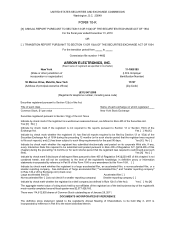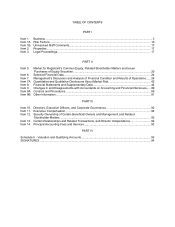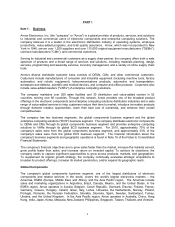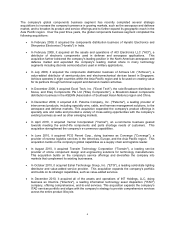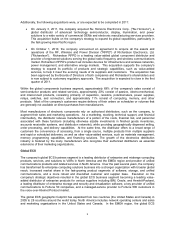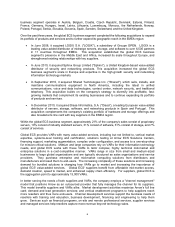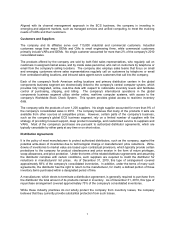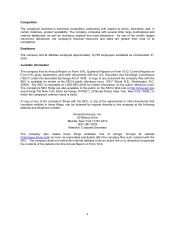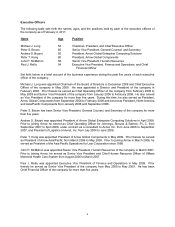Arrow Electronics 2010 Annual Report Download - page 13
Download and view the complete annual report
Please find page 13 of the 2010 Arrow Electronics annual report below. You can navigate through the pages in the report by either clicking on the pages listed below, or by using the keyword search tool below to find specific information within the annual report. 11
products sold by the company, if it is required to pay for the associated damages. Although the company
currently has product liability insurance, such insurance is limited in coverage and amount.
Declines in value and other factors pertaining to the company’s inventory could materially
adversely affect its business.
The market for the company's products and services is subject to rapid technological change, evolving
industry standards, changes in end-market demand, oversupply of product, and regulatory requirements,
which can contribute to the decline in value or obsolescence of inventory. Although most of the
company’s suppliers provide the company with certain protections from the loss in value of inventory
(such as price protection and certain rights of return), the company cannot be sure that such protections
will fully compensate it for the loss in value, or that the suppliers will choose to, or be able to, honor such
agreements. For example, many of the company’s suppliers will not allow products to be returned after
they have been held in inventory beyond a certain amount of time, and, in most instances, the return
rights are limited to a certain percentage of the amount of product the company purchased in a particular
time frame. All of these factors pertaining to inventory could have a material adverse effect on the
company’s business.
The company is subject to environmental laws and regulations that could materially adversely
affect its business.
The European Union ("EU"), China, and other jurisdictions in which the company's products are sold have
enacted or are proposing to enact laws addressing environmental and other impacts from product
disposal, use of hazardous materials in products, use of chemicals in manufacturing, recycling of products
at the end of their useful life, and other related matters. These laws include the EU Restriction of the Use
of Certain Hazardous Substances and Waste Electrical and Electronic Equipment Directives, the EU
REACH (chemical registration) Directive, the China law on Management Methods for Controlling Pollution
by Electronic Information Products, and various other laws. These laws prohibit the use of certain
substances in the manufacture of the company's products and directly and indirectly impose a variety of
requirements for modification of manufacturing processes, registration, chemical testing, labeling, and
other matters. Failure to comply with these directives or any other applicable environmental regulations
could result in fines or suspension of sales. Additionally, these directives and regulations may result in
the company having non-compliant inventory that may be less readily salable or have to be written off.
Some environmental laws impose liability, sometimes without fault, for investigating or cleaning up
contamination on or emanating from the company’s currently or formerly owned, leased, or operated
property, as well as for damages to property or natural resources and for personal injury arising out of
such contamination. As the distribution business, in general, does not involve the manufacture of
products, it is typically not subject to significant liability in this area. However, there may be occasions,
including through acquisitions, where environmental liability arises. For example, the company has
recently expanded into the information technology asset disposition business, or ITAD, pursuant to which,
the company is responsible to its customers to dispose of certain assets in an environmentally compliant
manner. The company's or its subcontractors' failure to comply with the applicable environmental laws
and regulations could result in additional liability. Such liability may be joint and several, meaning that the
company could be held responsible for more than its share of the liability involved. The presence of
environmental contamination could also interfere with ongoing operations or adversely affect the
company’s ability to sell or lease its properties. The discovery of contamination for which the company is
responsible, or the enactment of new laws and regulations, or changes in how existing requirements are
enforced, could require the company to incur costs for compliance or subject it to unexpected liabilities.
The foregoing matters could materially adversely affect the company’s business.


